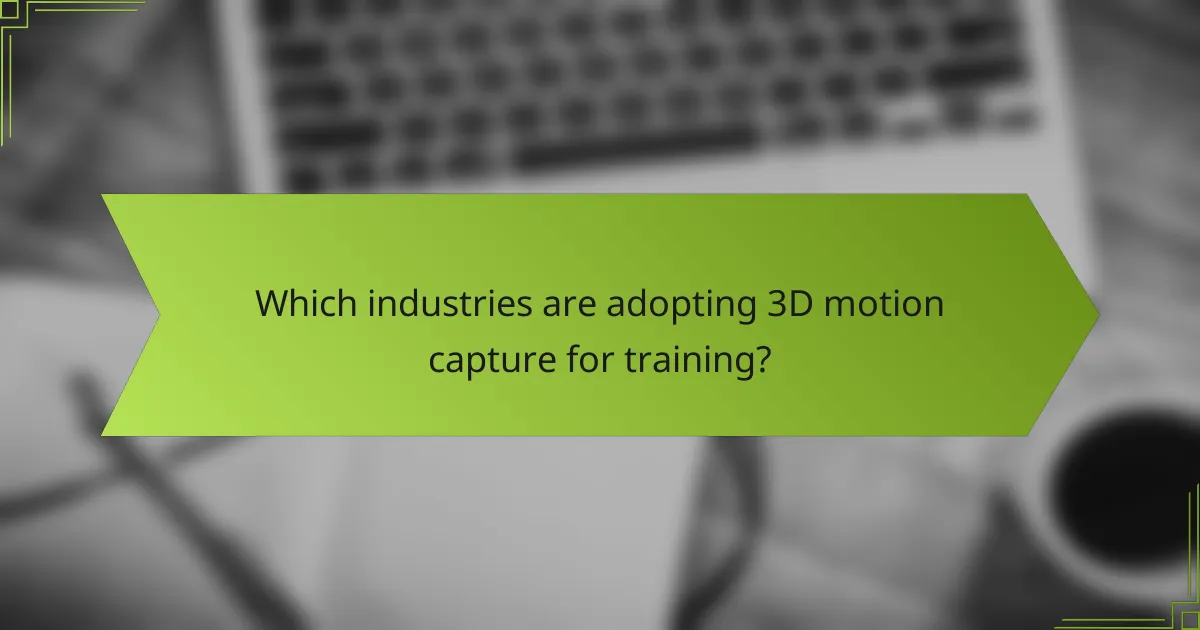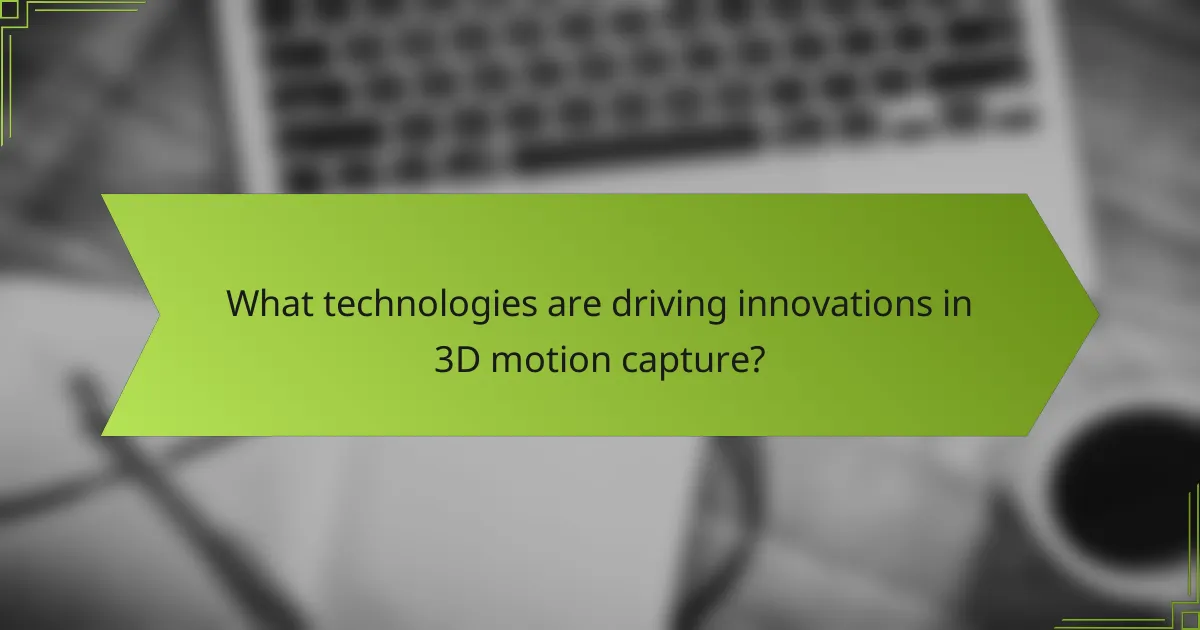3D motion capture technology is transforming education and training environments by offering immersive experiences that boost engagement and comprehension. By visualizing complex concepts and providing real-time feedback, this innovative approach enhances skill development across diverse fields, including performing arts, healthcare, and sports. As a result, learners benefit from tailored training sessions that lead to improved outcomes and deeper understanding.

How is 3D motion capture transforming education in the United States?
3D motion capture is revolutionizing education in the United States by providing immersive and interactive learning experiences that enhance student engagement and understanding. This technology allows educators to visualize complex concepts and facilitate hands-on training in various fields, from performing arts to physical education.
Enhanced interactive learning experiences
3D motion capture enables students to engage with educational content in a dynamic way, making learning more interactive. For instance, in dance or sports training, students can see their movements in real-time, allowing them to understand body mechanics better and improve their techniques.
Moreover, this technology can be used in science classes to simulate physical phenomena, helping students visualize and grasp abstract concepts. By incorporating motion capture into the curriculum, educators can create a more engaging learning environment that caters to different learning styles.
Real-time feedback for students
One of the key benefits of 3D motion capture in education is the ability to provide immediate feedback to students. As they perform tasks, such as athletic movements or artistic expressions, they receive instant data on their performance, allowing for quick adjustments and improvements.
This real-time feedback loop encourages students to refine their skills actively, fostering a growth mindset. Educators can utilize this data to tailor instruction to individual needs, ensuring that each student progresses at their own pace.
Integration with virtual reality platforms
3D motion capture can be seamlessly integrated with virtual reality (VR) platforms, creating fully immersive learning environments. This combination allows students to practice skills in simulated settings, such as virtual classrooms or performance stages, enhancing their learning experience.
For example, medical students can use VR combined with motion capture to practice surgical techniques in a risk-free environment. This integration not only boosts engagement but also prepares students for real-world applications, making their education more relevant and impactful.

What are the key benefits of 3D motion capture in training environments?
3D motion capture technology significantly enhances training environments by providing precise data on movement, which leads to better skill development and learning outcomes. This technology allows for real-time feedback and analysis, making training sessions more effective and tailored to individual needs.
Improved skill acquisition
3D motion capture facilitates improved skill acquisition by enabling trainees to visualize their movements in detail. This technology captures intricate details of physical actions, allowing learners to identify and correct mistakes quickly. For instance, athletes can analyze their techniques in sports like basketball or gymnastics, leading to faster mastery of skills.
By using motion capture data, trainers can create personalized training programs that address specific weaknesses, enhancing the overall learning experience. This targeted approach helps individuals progress at their own pace, ensuring a solid foundation before advancing to more complex skills.
Increased engagement and retention
Incorporating 3D motion capture into training environments boosts engagement and retention rates among learners. The interactive nature of this technology makes training sessions more dynamic and enjoyable, which can lead to higher motivation levels. For example, students in a dance class can see their movements compared to professional dancers, fostering a deeper connection to the material.
Additionally, the ability to track progress over time keeps learners invested in their development. When individuals can see tangible improvements in their performance, they are more likely to remain committed to their training regimen.
Cost-effective training solutions
3D motion capture can serve as a cost-effective training solution by reducing the need for extensive physical resources and facilities. While the initial investment in motion capture technology may be significant, the long-term savings on equipment, travel, and facility rentals can be substantial. For example, virtual training sessions can replace in-person workshops, minimizing expenses related to logistics.
Moreover, the efficiency gained through precise feedback can shorten training cycles, allowing organizations to achieve their training goals faster. This efficiency translates into lower overall costs per trainee, making motion capture a financially viable option for educational institutions and training programs.

Which industries are adopting 3D motion capture for training?
3D motion capture technology is increasingly being utilized across various industries for training purposes. Its ability to provide realistic simulations and detailed feedback enhances learning experiences in fields such as healthcare, sports, and entertainment.
Healthcare and medical training
In healthcare, 3D motion capture is revolutionizing medical training by allowing practitioners to practice procedures in a risk-free environment. For instance, surgical simulations can replicate real-life scenarios, enabling trainees to refine their skills without endangering patients.
Medical professionals can analyze their movements and techniques through recorded sessions, identifying areas for improvement. This technology not only enhances individual training but also facilitates collaborative learning among teams, ensuring better preparedness for actual medical situations.
Sports and athletic training
Sports training has embraced 3D motion capture to enhance athlete performance and reduce injury risks. By capturing an athlete’s movements in real-time, coaches can provide immediate feedback and tailor training programs to individual needs.
For example, a runner’s gait can be analyzed to improve efficiency and prevent injuries. This technology allows for precise adjustments in technique, which can lead to significant performance improvements over time.
Entertainment and game development
The entertainment industry, particularly in game development and film, utilizes 3D motion capture to create lifelike animations and characters. This technology captures the nuances of human movement, allowing for more realistic portrayals in games and movies.
Studios often employ actors to perform scenes while wearing motion capture suits, translating their movements into digital characters. This process not only enhances storytelling but also engages audiences with more relatable and dynamic performances.

What technologies are driving innovations in 3D motion capture?
Innovations in 3D motion capture are primarily driven by advancements in sensor technology, AI integration, and cloud-based processing. These technologies enhance the accuracy, efficiency, and accessibility of motion capture systems, making them more effective for education and training environments.
Advancements in sensor technology
Recent improvements in sensor technology have significantly increased the precision of motion capture systems. Modern sensors can capture motion data with low latency and high fidelity, often in real-time. This allows for more accurate representation of movements, which is crucial in training scenarios where detail matters.
For instance, optical sensors now utilize advanced algorithms to reduce noise and improve tracking in various lighting conditions. Additionally, inertial sensors have become more compact and affordable, making them accessible for educational institutions.
AI and machine learning integration
AI and machine learning are revolutionizing how motion capture data is processed and analyzed. These technologies can identify patterns in movement, enabling systems to predict and adapt to user behavior. This predictive capability enhances training environments by providing tailored feedback to learners.
Moreover, AI can automate the cleanup of motion capture data, reducing the time required for post-processing. This efficiency allows educators and trainers to focus more on content delivery rather than technical adjustments.
Cloud-based data processing
Cloud-based data processing is transforming the storage and analysis of motion capture data. By leveraging cloud technology, institutions can access vast computational resources without the need for expensive local hardware. This scalability is particularly beneficial for educational settings that require collaborative projects and remote access.
Furthermore, cloud solutions facilitate real-time sharing of motion capture data among users, enhancing collaborative learning experiences. Institutions can implement these systems with minimal upfront investment, making advanced motion capture technology more widely available.

How can educational institutions implement 3D motion capture?
Educational institutions can implement 3D motion capture by integrating advanced technologies into their curricula and training environments. This involves establishing partnerships with technology providers, developing relevant coursework, and investing in the necessary infrastructure and training for both students and faculty.
Partnerships with technology providers
Forming partnerships with technology providers is crucial for educational institutions looking to implement 3D motion capture. Collaborations can lead to access to the latest equipment, software, and technical support, which enhances the learning experience. Institutions should seek partnerships with companies specializing in motion capture technology to ensure they are using industry-standard tools.
These partnerships can also facilitate workshops and training sessions led by industry experts, providing students with hands-on experience. Institutions might consider co-developing projects or research initiatives that benefit both the students and the technology providers.
Curriculum development for motion capture
Developing a curriculum that includes 3D motion capture is essential for preparing students for careers in fields such as animation, gaming, and biomechanics. Courses should cover the fundamentals of motion capture technology, data analysis, and application in various industries. Incorporating practical projects will help students apply their knowledge in real-world scenarios.
Institutions should also consider interdisciplinary approaches, combining motion capture with subjects like computer science, art, and physical therapy. This broadens the skill set of students and makes them more versatile in the job market.
Investment in infrastructure and training
Investing in the necessary infrastructure is vital for successful implementation of 3D motion capture in educational settings. This includes acquiring motion capture systems, software licenses, and dedicated spaces for recording and analysis. Institutions should allocate budgets that reflect the costs of maintaining and upgrading this technology over time.
Additionally, training faculty and staff on the use of motion capture technology is essential. Regular professional development opportunities can help educators stay current with advancements in the field, ensuring they can effectively teach students and guide them in their projects.
